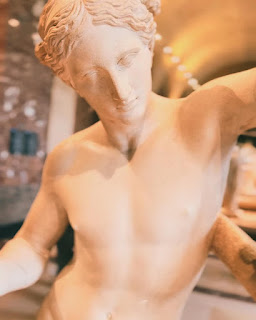Discover a teacher's unique Louvre encounters, from Greek beauty to Egyptian relics. Explore beyond Mona Lisa to uncover the Louvre's heart.
 |
| (2) Apollon Sauroctone |
 |
| (1) Éphèbe |
You can't expect to tour the Louvre and see it all. I've visited the museum three times; most recently this past February as a high school English teacher on a London and Paris school trip. My previous visits were in 2000 and 2001 as a college student. During the first of those trips, I explored the Denon wing, which houses the Louvre's iconic treasures — the Mona Lisa, the Winged Victory of Samothrace, the Coronation of Napoleon, and all those wonderful works of art. I was in awe, though I do recall the Mona Lisa looking more like a postcard (she still does, but we adore you, La Joconde!).
On this third visit, I began in the basement of the Sully wing and worked my way up, which proved to be immensely rewarding. And I did not even catch nary a glimpse of Leonardo's lady nor did I see the Nike (they live in my heart). Where the Éphèbe (1) and Apollo Sauroctone (2) reside is a vast collection of Greco-Roman sculpture, including the Venus de Milo. I was struck by the youthful Narcissus, whom I initially mistook for an athlete — he epitomizes Greek beauty and the stylized classical loveliness associated with the young and svelte. Similarly, there is the Apollo — it seems the gods enjoyed odd, vain acts like slaying lizards — apparently, this depicts Apollo as a protector. I had some knowledge of this piece prior to my visit, so seeing it in person was a delight.
Deep in the Sully wing lie the remnants of the Louvre's past life as a fortress before it became a royal palace and now a museum. The dungeon, curiously, serves as the storage for artifacts related to French history and the story of the Louvre complex. Here, I encountered a majestic sculpture representing the river (3) — there are actually two, but here we speak of one: the Seine. And I must say, I was captivated by him.
The Louvre's Egyptian wing is dizzying, with fifteen thousand objects from their massive half-a-million-piece collection. Even after seeing Egyptian art in numerous museums, the Louvre's assemblage feels personal and well-organized. The procession of sphinxes (4) in Room 327 was a charming touch — I half-expected one to spring to life and pose the classic riddle about the creature that walks on four legs in the morning, two in the afternoon, and three in the evening.
A three-thousand-year-old Egyptian statue (5), likely once part of a fierce work, is displayed, and it caught my attention, especially because of its eyes. It reminded me of how Percy Bysshe Shelley envisions the sculptor of Rameses II (now in the British Museum), meticulously carving the pharaoh's visage, well aware of the emperor's demands for precision.
And finally, I returned to that room that first captured my heart — Room 344 — where a statue of Zeus, or technically Jupiter (6) (since it's a Roman piece), stands from the second century. And, goodness, what a figure he cuts!
![Un fleuve Barye, Antoine Louis. Un fleuve. 19th century, France. Musée du Louvre, Department of Sculptures of the Middle Ages, Renaissance, and Modern Times, inventory number RF 1560 & RF 1561. Louvre Museum, Sully, [HIST LOUVRE] Salle 134 - Salle de la maquette, Vitrine 08](https://blogger.googleusercontent.com/img/b/R29vZ2xl/AVvXsEhRE9YnlXlK6KfP-A0z_dJZYnBT7_1M5T9D3tZk_gXozKs9gMd9nO9UXlkT5TkHi9T0KkSBwjL6qcfr74jTaMOtO6h47D1jJt4P6LadIo9MGzu3yL8o9KabJ2TLnGC05aMOJLGXy08A5kn4PeMuqb1xi3BchLe5z6tW_ddtYaAY0Te_gBcwPo7btQ/w180-h320/A65BC7E3-435F-4BF6-9AEE-992B60DCA921.jpg) |
| (3) Un fleuve |
![Statue of a Sphinx Musée du Louvre. Statue of a Sphinx. Circa 380-362 B.C. [?], Serapeum of Memphis, Saqqara. Musée du Louvre, Department of Egyptian Antiquities, Room 327, Sully, inventory number N 391 D. Louvre Museum](https://blogger.googleusercontent.com/img/b/R29vZ2xl/AVvXsEjgUwtk13qrP7vP1aawA_H8HLkuH_Om2fdXDUYZS5rp9gzDUj93w2JqthNzZp3HNWS8AsQqXaXeJC5UwcvtUI0RDp8NLgjTSiUTlm3d7iOqPGBZHf7o5BGbsuMqcyb0dXuT7bz1agggYfGBhFF45As03mepTGdzalqV6E6H9gy3r1oIJpCqEAcp_A/w256-h320/2B604D01-4603-465D-9A7E-BE621258F15E.jpg) |
| (4) Statue of a Sphinx |
![Statue Musée du Louvre. Statue. Third Intermediate Period, circa 1069-664 B.C. [?]. Musée du Louvre, Department of Egyptian Antiquities, inventory numbers E 2410; N 1579; Clot bey C 25 no. 5. Louvre Museum](https://blogger.googleusercontent.com/img/b/R29vZ2xl/AVvXsEjgbctrJI65LJI1iyrVOfQhyphenhyphene1Tc7QGTT4wcBmC08D_-9ItrigFHgGkqlDv2rPXfIA1CmP6V8ZIqsfUQ7CGr0K2fEwD4wjU7gBYdxKLbgTQEFFjb50Ge3hY9aGWehNd6EDdhxp35uN-0HYHIBL-vXWIXJD-NcecFiFCi6zVnQWKKJnMVmExZpZKfQ/w256-h320/75DFE6FB-8092-4AAD-8E84-5475A684CEDD.jpg) |
| (5) Statue |
![Jupiter Musée du Louvre. Jupiter. 2nd century A.D. [?], Italy. Musée du Louvre, Department of Greek, Etruscan, and Roman Antiquities, Room 344.](https://blogger.googleusercontent.com/img/b/R29vZ2xl/AVvXsEh9FIeOZBWXHqm5AryH2Cb0EdwkG_C2QX7rHPa3IQTeF_q7JBsmrEfeSbekVmJaSLsg_k0Zb9dCdUctsB_i8rQA2dVqXkSQoBwP9IxfPLOA-5B4ufz0bVSvIVbKjqkpQeJ2U2Gl6C53r3ylcqsay29L5YfAPJNU4zaHvj3boIWM6pv3BF-rpLhZqA/w256-h320/72D6CC7E-0683-4B1E-AA7E-FA3A9611BA85.jpg) |
| (6) Jupiter |
Citations:
(1) Louvre Museum. Narcisse (Type, Original en Bronze) - Éphèbe (Boucle, Court, Nu, Appuyé, Sur Pilier, Bas). 2nd century A.D., Basse Égypte. Louvre, Department of Greek, Etruscan, and Roman Antiquities, Sully wing, ground floor, room 344, item Ma 457. https://collections.louvre.fr/ark:/53355/cl010278134.
(2) Louvre Museum. Apollon Sauroctone. 2nd quarter 1st century A.D., Italy. Louvre, Department of Greek, Etruscan, and Roman Antiquities, Sully wing, ground floor, room 344, item Ma 441. https://collections.louvre.fr/ark:/53355/cl010278000.
(3) Barye, Antoine Louis. Un fleuve. 19th century, France. Musée du Louvre, Department of Sculptures of the Middle Ages, Renaissance, and Modern Times, inventory number RF 1560 & RF 1561. Louvre Museum, Sully, [HIST LOUVRE] Salle 134 - Salle de la maquette, Vitrine 08 https://collections.louvre.fr/en/ark:/53355/cl010093894.
(4) Musée du Louvre. Statue of a Sphinx. Circa 380-362 B.C. [?], Serapeum of Memphis, Saqqara. Musée du Louvre, Department of Egyptian Antiquities, Room 327, Sully, inventory number N 391 D. Louvre Museum, https://collections.louvre.fr/en/ark:/53355/cl010009175.
(5) Musée du Louvre. Statue. Third Intermediate Period, circa 1069-664 B.C. [?]. Musée du Louvre, Department of Egyptian Antiquities, inventory numbers E 2410; N 1579; Clot bey C 25 no. 5. Louvre Museum, https://collections.louvre.fr/en/ark:/53355/cl010013953.
(6) Musée du Louvre. Jupiter. 2nd century A.D. [?], Italy. Musée du Louvre, Department of Greek, Etruscan, and Roman Antiquities, Room 344. https://collections.louvre.fr/en/ark:/53355/cl010277023.

No comments:
Post a Comment
Be courteous. Speak your mind. Don’t be rude. Share.